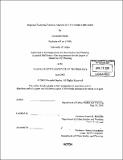Regional economic function analysis of U.S. foreign-trade zones
Author(s)
Otsubo, Hirotoshi
DownloadFull printable version (8.328Mb)
Other Contributors
Massachusetts Institute of Technology. Dept. of Urban Studies and Planning.
Advisor
Karen R. Polenske.
Terms of use
Metadata
Show full item recordAbstract
Foreign-Trade Zones (FTZs) are defined as designated areas in the United States where foreign merchandise is considered to be international commerce and not subject to U.S. customs duties unless or until it enters into the U.S. market. The original purpose of the FTZ program was to generate new business and employment in the United States by encouraging foreign trade, especially export and transshipment trade. Since the early 1980s, the program has grown in popularity in terms of the number of FTZs established and the value of goods traded through them. Meanwhile, the program has shifted its primary function from export promotion to import promotion. Today, offshoring manufacturers, such as oil refineries and auto-assembly plants, are the major beneficiaries of the program. They can reduce the payment of customs duties by converting high-duty imported materials into low-duty finished products under FTZ procedures. This import-oriented activity is enabled by the liberality of the FTZ Act and administrative support from the FTZ Board. FTZ #27, located around Boston Harbor, is not an exception. Since the late 1990s, this zone has amplified its function in import promotion by accommodating several distributors, including BOSFUEL and Reebok. Under FTZ procedures, these firms can benefit considerably from duty exemption and deferral. I estimated that the cost savings reach 940,000 dollars at BOSFUEL and 1.1 million dollars at Reebok. However, FTZ #27 has failed to generate employment both at the local and regional levels. The number of workers in the zone has declined by 61% since 1999 because employment loss at existing manufacturers has outpaced the increase at BOSFUEL and Reebok. (cont.) Also, I estimated that the import promotion of jet fuel and footwear creates only limited employment in Greater Boston. This is mostly because FTZ #27 lacks locational incentives and supply-chain linkages that would initiate regional economic growth. This case study indicates that, through the functional shift, the FTZ program is losing its economic significance for regional economies. This suggests that the program requires substantial modifications in policy and administration to improve its efficacy.
Description
Thesis (M.C.P.)--Massachusetts Institute of Technology, Dept. of Urban Studies and Planning, 2005. Includes bibliographical references (leaves 86-88).
Date issued
2005Department
Massachusetts Institute of Technology. Department of Urban Studies and PlanningPublisher
Massachusetts Institute of Technology
Keywords
Urban Studies and Planning.